This month, Electric Consumer introduces a new column that will alternate monthly with Jack Spaulding’s “Great Outdoors.” “Do-It-Yourself,” produced in cooperation with Do it Best Corp., will offer tips on how to tackle various projects homeowners must deal with regularly. Let us know what you think of the column and the alternating schedule with Jack’s “Great Outdoors.”
By Joel Bolinger
Trees and shrubs offer many benefits in home landscaping, such as adding curb appeal, providing shade, blocking wind, reducing air pollution, marking boundaries and enhancing privacy. Given the size and longevity of trees and shrubs, and the difficulty of repositioning them once they’re established, a little planning before you plant can help you avoid potential problems and enhance long-term enjoyment.
Here are some things to consider beyond the obvious sunlight and moisture requirements.
• Consider mature size. As the tree or shrub grows, will it still be appropriate for its location? While you can’t predict exact mature size, the estimates on nursery tags are useful guidelines. When deciding what and where to plant, consider whether growing branches will obstruct views, block entrances or walkways, or create other concerns. If extensive pruning would be needed, a different species or location may be more fitting.
• Plant away from buildings. A mature tree’s root system extends far beyond the trunk diameter. Trees too near your house, outbuildings, sidewalks, paved driveways, patios, pools, etc., can cause structural damage as the roots spread. With shrubs this isn’t often a concern, but a good guideline for trees is to plant species with mature heights of up to 25 feet at least 15 feet away. For mature heights between 25 and 50 feet, plant at least 30 feet away. For heights over 50 feet, plant at least 50 feet away.
• Call 811 before planting. Call to have underground pipes and utilities marked at least a few working days before digging. Knowing their locations helps you dig safely, and planting a safe distance away will help prevent damage from roots.
• Avoid power lines. Trees and shrubs near power lines interfere with utility workers’ duties, and branches can knock down lines and cause outages. As a general guideline, it’s best not to plant a tree where it would grow within about 25 feet of a power line. Branches that grow too close to power lines will need pruning, and that’s dangerous and expensive work. Never prune near power lines yourself; contact the utility company for help.
• Fruits and nuts have pros and cons. Fruit and nut trees and berry bushes attract wildlife, which can be a pleasure or a nuisance depending on your viewpoint. If you plant them near parking areas, you may be cleaning a lot of bird droppings and fruit off your vehicles. Also, avoid planting poisonous species where young children could access them.
• Plant for energy savings. Please turn to page 10 for details.
• Don’t give burglars a break. Tall, thick shrubs near doors or windows can provide cover for criminals. Plan to keep shrubs in these areas trimmed to a maximum height of three feet – or choose species with thorns!
• Be considerate when planting living fences. Fences don’t always make for good neighbors. Before planting trees or shrubs as property dividers, consider their mature size. If you can’t position them entirely on your property, check with the neighbors first as a courtesy. Everyone should agree on the decision to plant, the species selection, and the assumption of maintenance duties and costs.
Visit your local Do it Best location or go online to doitbest.com for home improvement products, including all of your spring planting essentials!

Joel Bolinger is owner of Kendallville Do it Center and Garrett Do it Best Hardware.
Headquartered in Fort Wayne, Do it Best Corp. is a member-owned cooperative of thousands of hardware stores, home centers and lumberyards throughout the United States and around the world.
This article is for informational purposes only. Electric Consumer and Do it Best Corp. assume no liability for the accuracy or completeness of its content, or for injuries, property damage, or the outcome of any project.



